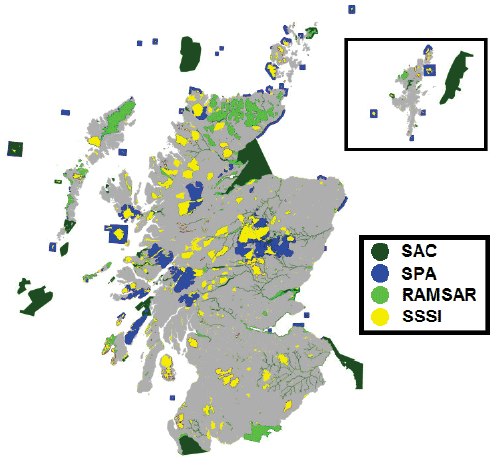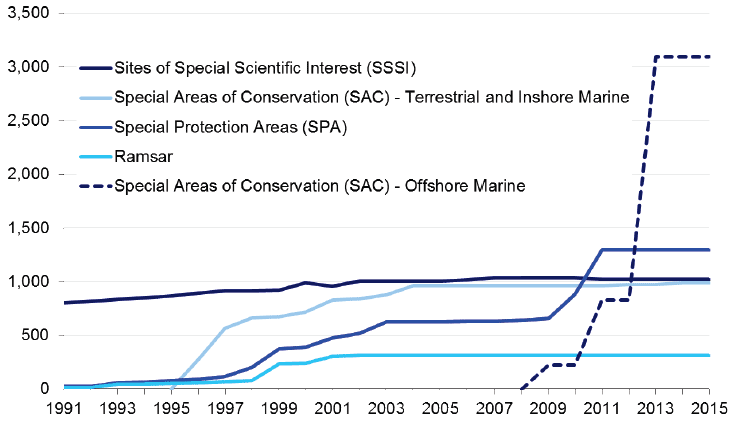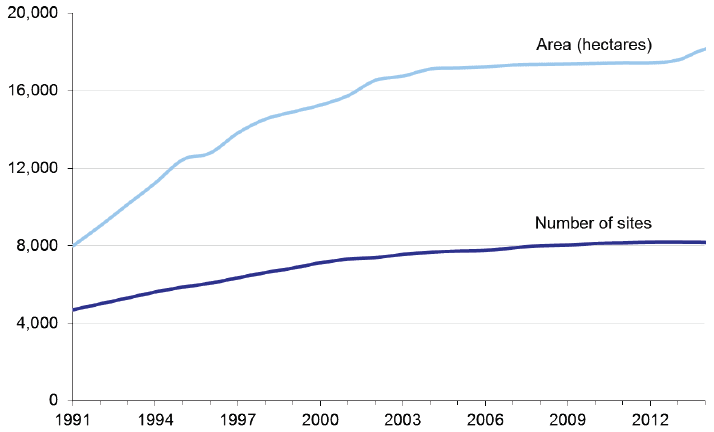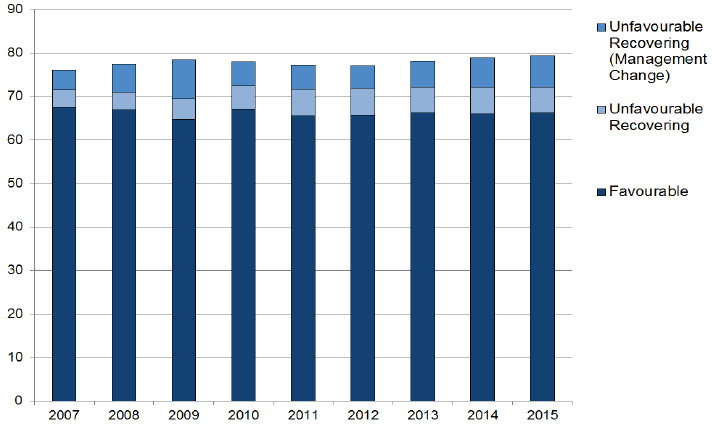Key Scottish Environment Statistics 2015
This publication aims to provide an easily accessible reference document which offers information on a wide range of environmental topics. It covers key datasets on the state of the environment in Scotland, with an emphasis on the trends over time wherever possible. The data are supplemented by text providing brief background information on environmental impacts and data source, a summary of the trend and brief information on the potential factors affecting the trend.
Conservation
Background
Conservation is the protection and maintenance of biological, geological and cultural resources. For the most part, it relies on identifying and valuing species, areas and structures within Scotland that require sensitive management. The legal protection of habitats, buildings and archaeological sites plays a part in securing their future, preventing their damage, destruction or inappropriate exploitation. This preserves the cultural and biological distinctiveness of Scotland which we value highly as a society. The conservation of species is covered in the Biodiversity Chapter, while this chapter deals with the protection of structures, land and water areas.
Legal inclusions
Legal protections are provided by a wide range of legislation, both national and international. Different types of asset are protected by different legislation and protection can apply to individual buildings or to larger land and sea areas.
Protected areas in Scotland measured in KSES
SAC: Special Area of Conservation
SPA: Special Protection Area
Ramsar: Convention on the conservation of wetlands
SSSI: Site of Special Scientific Interest
Scotland also has protected sites around its marine areas beyond those pictured here.
Some protected sites are cross border between Scotland and England.

© Crown copyright and database right (2015). Ordnance Survey (OS Licence number 100024655) Conservation areas from Scottish Natural Heritage.
Targets and National Indicators
National Indicators: Improve the condition of protected nature sites
Designated Areas: 1991-2015[118]
Area (thousand hectares)[119],[120]

Why this measure is important
Designated areas provide protection for areas of cultural or biological importance.
Background
Designated sites, including Sites of Special Scientific Interest (SSSIs)[121], Special Areas of Conservation (SACs)[122], Special Protection Areas (SPAs)[123] and Ramsar[124] sites, protect flora, fauna, geological or physiographical features of outstanding quality in terrestrial and coastal environments. In 2015, there were 1,423 SSSIs, 252 SACs, 153 SPAs and 51 Ramsar sites in Scotland.
Trend
The total area of SSSIs in Scotland has steadily increased from 804,000 hectares (ha) in 1991 to 1,022,350 ha in 2015 (about 13% of land in Scotland). The area of terrestrial and inshore marine SACs rose from 0 ha in 1995 to 963,000 ha in 2004 and has since remained broadly stable, rising to 986,705 ha in 2014 and remaining at that level since. In 2015, there were 11 offshore SACs covering a total area of 3,094,778 ha. The area of SPAs rose from 26,000 ha in 1991 to 1,297,000 ha in 2011 where the level has remained since.
Factors affecting trend
In 2009, Scottish Ministers classified 31 marine extensions to existing seabird breeding colony SPAs around Scotland's coasts and classified six new SPAs for golden eagle in 2010 which contributed to the large increase in SPA area of 639,387 ha between 2009 and 2011. The increase of 2,082,000 ha in the area of offshore SACs from 2012 was mainly due to the introduction of the SAC at Hatton Bank, which covers 1,569,000 ha.
Source: Scottish Natural Heritage | Metadata
Scheduled Monuments: 1991-2015[125]
Number and area of sites designated as Scheduled Monuments

Why this measure is important
Historic Scotland is responsible for safeguarding the nation's historic environment and promoting its understanding and enjoyment. One way to achieve this is by legally protecting nationally important sites and monuments through designation as 'scheduled monuments'.
Background
Scheduled monuments (SMs) are protected under the Ancient Monuments and Archaeological Areas Act 1979[126] and range from the earliest traces of settlement and human activity over 10,000 years ago to Second World War coastal batteries. Once a monument is scheduled, the prior written consent of Scottish Ministers is required for most works or activities in the scheduled area to help ensure the monument is not damaged or destroyed - this process is known as 'scheduled monument consent'.
Trend
The number of SMs has increased by 74% between 1991 and 2015 and the area they account for has increased by 127% over the same period. In 2015, there were 8,184 designated SMs in Scotland, covering an area of 18,177 hectares (ha).
Factors affecting trend
Recent changes are due to an ongoing review of SMs[127],[128] which may involve the rescheduling or rationalisation of some sites. There are SMs spread across Scotland, with more added to the Schedule every year, but numbers vary across local authorities. In 2015, the largest number of SMs was in Highland Council, with 1,241 SMs covering 2,688 ha.
Source: Historic Scotland | Metadata
Percentage of natural features on protected sites in favourable condition: 2007-2015[129]
Percentage of natural features (%)

Why this measure is important
Scotland's protected sites have been identified as areas with 'special' species, habitats, natural rocks or landforms, or a combination of these. Protecting these areas is important for maintaining sensitive or biologically important natural features and makes a key contribution to safeguarding Scotland's biodiversity.
Background
Data are obtained from Scottish Natural Heritage's (SNH) Site Condition Monitoring programme[130], and are used to inform the National Indicator: Improve the condition of protected nature sites[131].
Trend
As at 31st March 2015, 79.3% of natural features on protected nature sites were assessed as being in favourable condition. This figure represents an increase of 0.5 percentage points from 2014 and has increased by 3.3 percentage points from 76.0% in 2007.
Factors affecting trend
This trend can be affected by the actions of the responsible bodies, land owners and users of individual protected sites. Many natural features assessed as unfavourable need specific, and sometimes complex, collaborative actions (e.g. management of wild deer populations) to bring them into favourable condition. Influences from outside the protected site itself, for example climate change, can also influence the condition of individual sites.
Source: Scottish Natural Heritage | Metadata
Contact
Email: Kirsty Ciclitira
There is a problem
Thanks for your feedback